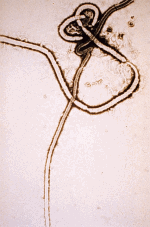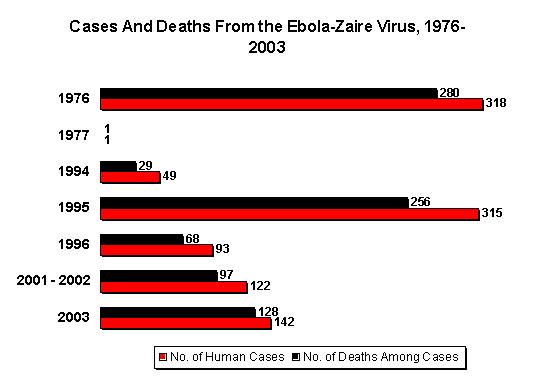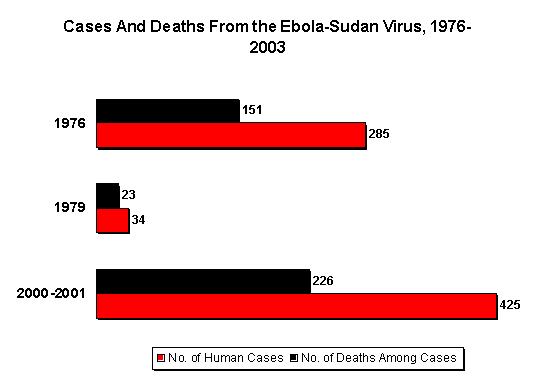As of June 25, public health authorities have identified 296 persons with viral hemorrhagic fever (VHF) attributable to documented or suspected Ebola virus infection in an outbreak in the city of Kikwit and the surrounding Bandundu region of Zaire (1)(2); 79% of the cases have been fatal, and 90 (32%) of 283 cases in persons for whom occupation was known occurred in health-care workers. This report summarizes characteristics of persons with VHF from an initial description of cases and preliminary findings of an assessment of risk factors for transmission.
A case was defined as confirmed or suspected VHF in a resident of Kikwit or the surrounding Bandundu region identified since January 1. The median age of persons with VHF was 37 years (range: 1 month-71 years); 52% were female. Based on preliminary analysis of 66 cases for which data were available, the most frequent symptoms at onset were fever (94%), diarrhea (80%), and severe weakness (74%); other symptoms included dysphagia (41%) and hiccups (15%). Clinical signs of bleeding occurred in 38% of cases.
Potential risk factors for intrafamilial transmission were evaluated for secondary cases within households of 27 primary household cases identified through May 10. A primary household case was defined as the first case of VHF in a household; household was defined as persons who shared a cooking fire at the onset of illness in the primary household case. Among 173 household members of the 27 primary household cases, there were 28 (16%) secondary case-patients. The risk for developing VHF was higher for spouses of the primary household case-patients than for other household members (10 [45%] of 22 compared with 18 [14%] of 151; rate ratio [RR]=3.8; 95% confidence interval [Cl] = 2.0 - 7.2) and for adults (aged [great than or equal] 18 years) than for children (24 [30%] of 81 compared with four [4%] of 92; RR = 6.7; 95% Cl = 2.4 - 18.4).
Needle sticks or surgical procedures during the 2 weeks before illness were reported for two of the 27 primary household case-patients and none of 28 secondary case-patients. Of the 28 secondary case-patients, 12 had direct contact with blood, vomitus, or stool of the ill person during hospitalization (i.e., later stages of illness), and 17 simultaneously shared the same hospital bed. Of 78 household members who had no direct physical contact with the person with the primary household casepatient during their clinical illness, none developed VHF (95% Cl = 0 - 4).
Reported by: M Musong, MD, Minister of Health, Kinshasa; T Muyembe, MD, Univ of Kinshasa; Technical and Scientific International Coordinating Committee for Viral Hemorrhagic Fever, Kikwit, Zaire. World Health Organization Kinshasa, Zaire. World Health Organization, Brazzaville, Congo. World Health Organization, Geneva, Switzerland. Medecine and Hygiene, Antwerp, Belgium. Div of Viral and Rickettsial Diseases, National Center for Infectious Diseases; International Health Program Office; Epidemiology Program Office, CDC.
Editorial Note: The incidence of VHF related to Ebola virus in Kikwit has diminished following the institution of interventions including 1) training of medical and relief personnel on the proper use of protective equipment, 2) initiation of aggressive casefinding; and 3) educational measures in the community (e.g., pamphlets and public announcements)(1)(2). However, cases continue to occur, and each case has the potential to be a source for additional infections. Therefore, ongoing measures including continued intensive surveillance, training activities, and public education are necessary to contain the epidemic.
To maximize prevention and control measures, prompt laboratory diagnosis is an important component of surveillance. An enzyme-linked immunosorbent assay (ELISA) detected Ebola antigen in specimens initially submitted to CDC from 11 of 13 acutely infected persons (1). Ongoing testing of additional specimens will assess the utility of this ELISA as a rapid diagnostic test that could be used locally. In addition, Ebola antigen was detected in multiple formalin-fixed tissue samples (liver, lung, and skin) of seven case-patients by immunohistochemical (IHC) staining using a specific polyclonal antibody. These findings suggest that IHC staining of fixed tissue may assist in surveillance for hemorrhagic fevers in Africa and other countries. Other activities include ecologic studies to identify the natural reservoir of the virus; these studies are focusing especially on mammals, nonmammalian vertebrates, and arthropods.
[ILLUSTRATION OMITTED]
TABLE I. Summary -- cases of specified notifiable diseases, United
States, cumulative, week ending June 24, 1995 (25th Week)
(*)The case previously reported in 1995 had onset of illness in October 1994. It will now be included in 1994 data.
([dagger])Of 596 cases of known age, 147 (25%) were reported among children less than 5 years of age.
([sections])Updated quarterly from reports to the Division of Sexually Transmitted Diseases and HIV Prevention, National Center for Prevention Services. First quarter data not yet available. -: no reported cases
Transmission associated with health-care providers and caregivers has been a prominent feature of the current and previous VHF outbreaks in Africa attributable to Lassa, Marburg, Ebola, or Crimean-Congo hemorrhagic fever viruses (3). In some outbreaks, transmission from patient to patient within hospitals has been associated with the reuse of unsterile needles and syringes. As in previous outbreaks, high rates of transmission in this outbreak have occurred from patients to health-care workers and to family members who provided nursing care without appropriate barrier precautions to prevent exposure to blood, other body fluids, vomitus, urine, and stool. Based on findings in this report, the risk for transmitting infection from patients appears to be highest during the later stages of illness, which is characterized by vomiting, diarrhea, shock, and often hemorrhage. However, a small number of cases of VHF in Zaire have been reported in family members whose only contact with an infected person was in the domestic setting within a few days after onset of illness.
Updated recommendations for the management of VHFs attributable to these viruses in the United States are presented in a Notice to Readers in this issue (4).
[TABULAR DATA OMITTED]
References
(1.)CDC. Outbreak of Ebola viral hemorrhagic fever--Zaire, 1995. MMWR 1995; 44:381-2.
(2.)CDC. Update: outbreak of Ebola viral hemorrhagic fever--Zaire, 1995. MMWR 1995; 44:399.
(3.)CDC. Management of patients with suspected viral hemorrhagic fever. MMWR 1988; 37(no. S-3):1-15.
(4.)CDC. Update: management of patients with suspected viral hemorrhagic fever--United States. MMWR 1995; 44:475-79.
COPYRIGHT 1995 U.S. Government Printing Office
COPYRIGHT 2004 Gale Group




